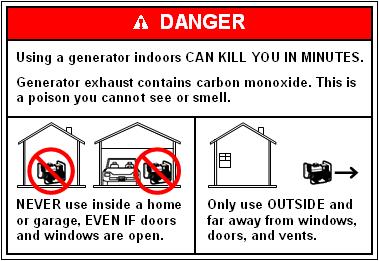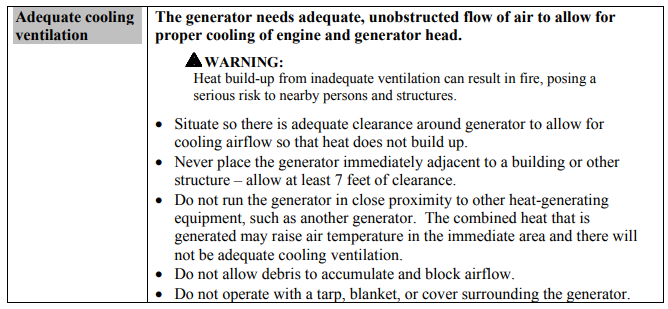![]()
Can Generators Get Wet? [Using Generator in Rain]
DISCLAIMER: AS AN AMAZON ASSOCIATE I EARN FROM QUALIFYING PURCHASES. THIS POST CONTAINS AFFILIATE LINKS THAT WILL REWARD ME MONETARILY OR OTHERWISE WHEN YOU USE THEM TO MAKE QUALIFYING PURCHASES. FOR MORE INFORMATION, PLEASE READ MY EARNINGS DISCLAIMER.
The generator should never be used in wet conditions, according to warning signs on labels from the manufacturers. Why? Damage to the generator and electric shock are two primary concerns.
Even though water by itself does not conduct electricity, it is a “universal solvent” (according to this source), and the dissolved elements, especially salts, are excellent conductors! This is how “mixing water and electricity” becomes really dangerous and fatal.
So, this basically means:
“No ions, no problem!”
If nothing is dissolved in water, it will not conduct electricity! Unfortunately, rainwater is NOT pure and we have something to worry about!
Electrocution can occur when using a generator or electrical device in wet weather, such as rain or snow, or near a pool or sprinkler system, or while your hands are moist. Moisture or ice can cause electrical components to malfunction or short circuit, which can result in overloading your circuit and possibly damaging some appliances.
Why can’t portable generators be used when it’s raining outside? The possibility of water getting into the outputs. If you have a GFCI (Ground Fault Circuit Interrupter) outlets, if they become wet, they automatically shut off
In fact, if the electrical panel on your portable generator becomes wet, it could cause damage and electrocution. Most generators will have a warning against “wet conditions” mentioned somewhere on the label or in their owner’s manual:
The solution to this situation is also mentioned in the example above and we will go over it below. You want to get the generator going, but be safe, don’t you?! So, how do we keep our generator from getting wet?
Is a garage a good solution for keeping the generator dry?
The most common cause of CO poisoning, according to the Consumer Products Safety Commission, is running a portable generator in the garage with the exhaust pointed outward. Since a 2007 Consumer Product Safety Commission rule, all generators must display the following warning label:
Or a very clear indication that it should NOT be done. Picture source
Most people are aware that using a portable generator inside a garage or near an open window is extremely risky. A generator should always be placed at least 10 feet away from your home, according to most manufacturers’ recommendations.
Portable generator CO levels are 1500 times greater than modern automobile engines, according to studies. As a result, it’s always a good idea to keep the generator outside and away from habitation.
Never use a generator inside your house or in a garage. It makes no difference if the doors were left open. The only acceptable shelter for a generator could be a specifically designed fort or someplace that people do NOT enter (see our article on how to quite a generator.)
Carbon monoxide is colorless, odorless, and weighs more than air, making it more dangerous. As a result, this killer gas has the capacity to quickly accumulate and build up in any location.
As previously stated, simply opening the garage door does not ensure that CO will exit the garage. On the contrary, if the wind is blowing inward, the deadly gas can enter your home.
It will easily diffuse through door or window seal holes. Even if the garage or shed was partially separated, keep in mind that CO might remain for several hours. Here is a good summary of portable generator hazards (PDF file).
So, now we have a problem! We cannot keep the generator inside AND chances are very high that it could rain while it is standing outside. Does anyone really know when it will rain?
Can you run a generator in the rain?
Yes, it’s possible to operate a generator in the rain as long as you have a specially designed cover to keep it dry. Be aware of manufacturers warning and proceed with caution:
Power outages are the most prevalent reason for using a portable generator, but why in a world are they usually happening during heavy rain or snowstorm? If not protected correctly, a storm can damage your generator and in the worst-case scenario, electrocute somebody…
It’s important to remember that electricity and water don’t mix (I mentioned the reason above). This is why unless you have a generator tent, you should never try to start or run your generator in the rain. Water can easily allow the electric current to flow in the not intended direction and add you to its circuitry!
So, what do we do? Let’s go to our next point!
Generator shelters
Construct an outside shelter for the generator is possible if you follow basic rules:
- Your shelter should your generator from water on ALL sides, including the bottom.
- Your shelter should provide good airflow (to avoid overheating).
- Your generator should be fire-resistant.
If you did your research already about generator coverings and shelters, you probably found out that many of they do not fulfill at least one of the requirements. However, requiring all three is not unreasonable!
The first thing to do before setting up your generator shelter, however, is to find a location where your generator will NOT face flooding issues. There is no point in setting up a shelter if the generator will be flooded from the bottom!
If you know that a tropical storm is coming by, this type of shelter should be sufficient:
![]()
Ready-made generator tents
Specifically designed generator tents could also be a good solution for you and you can get them from Amazon (paid link):
The above GenTent (paid link) is fire resistant and can withstand winds up to 70MPH! It makes enough room for ventilation and can even handle 18 inches of snow (about 55lbs).
What I like about the tent above, is that it was independently tested in the lab. The canopy and other tent components are flame retardant and passed NFPA 701 test.
When you decide to use an over-the-counter tent shelter, make sure that you read as many reviews as possible and get a brand with a good reputation. It will also help if the design and materials have compliance certificates.
Don’t forget to make sure to select the correct tent type for your generator! Some are suitable for inverter-generators, some are not! Tents are designed differently to accommodate your specific generator type.
They have various openings for exhaust (read carefully if it suits your generator), extra flaps to add extra protection for the control panel, and resealable access flaps for refueling. They can also be designed to mount directly on the frame of the generator (some models).
Once again, don’t forget that generators should be placed on the elevated area and if you don’t find it, it’s a good idea to make it! Flooding your generator while it runs is something that you probably DO NOT WANT!
Here is another type of enclosure tent (clickable paid link):
Do not confuse heavy duty fire resistant shelters with simple generator covers! If you do not know which one is which, if it’s cheap, it’s a cover and DO NOT GET it (unless you need it for storage).
DYI gen tents
If building things come easy to you, then creating an adequate generator shelter should not be a problem! All you have to do is to make sure it is covered, “still breathing” and reasonably easily accessible.
![]()
One thing about building a shelter out of wood is that it is NOT totally fireproof. If a generator can burn fuel, it may easily burn any wooden shed that surrounds it.
Unless you have a newer type of generator, it may also create sparks that are coming out of the electrical outlets. If wood is utilized, take great care to ensure that the interior is fireproof by using a fire retardant spray (paid link).
When working on your generator shelter, make sure that it’s both waterproof and fireproof. Here is a state of art enclosure for you to check out:
![]()
The cost? Who knows… But it’s darn good!
Conclusion
In reality, in the event of a storm or other severe weather, you should never use the generator and NOT because of the rain. It is very common for heavy objects (like generators), to move around unless it is somehow bolted to the ground!
 When wind speed is close to 60 or 70 mph, If you try to operate your generator, the outcome might be disastrous. Back in Russia (where we have a lot of snowstorms), having a generator was not an option for me, and my family got used to light their way with candles…
When wind speed is close to 60 or 70 mph, If you try to operate your generator, the outcome might be disastrous. Back in Russia (where we have a lot of snowstorms), having a generator was not an option for me, and my family got used to light their way with candles…
Besides keeping your generator raised and away from the ditches, another safety thing you may want to consider is a surge protector. It is especially helpful in bad weather when something can easily go wrong regardless of how carefully you planned everything out.
It will suppress excessive energy spikes that may come out of your generator and keep your sensitive appliances and electronics safe. Only make sure that your surge protector is meant for outdoor use, like these ones:
- 30 amp surge protector (paid link)
- 50-amp surge protector(paid link)
When doing anything with a generator in bad weather, it is suggested that you should wear rubber-soled shoes. If you need to touch a generator, always use just one hand. This will prevent the formation of a circuit through the body.

Click on the white button above to find your electrician!








